PM4Flower: A Scriptable Parametric Modeling Interface for Procedural Flower Generation Using PM4VR
DOI: https://doi.org/10.1145/3708635.3708645
ICSIE 2024: 2024 13th International Conference on Software and Information Engineering (ICSIE), Derby, United Kingdom, December 2024
In this paper, we introduce PM4Flower, a novel scriptable parametric modeling interface providing users with a flexible system for procedurally generating diverse flower models through parametric controls. PM4Flower allows users to write intuitive scripts to craft realistic flower models for a wide range of applications, from VR/AR environments to visual effects in film and games. This research outlines the design principles behind PM4Flower, the procedural techniques employed, and the parametric scripting interface that empowers users to define detailed, customized flower structures. We also demonstrate the effectiveness of generating different types of realistic flower models using the PM4Flower interface, highlighting its strengths in creativity and flexibility.
ACM Reference Format:
Wanwan Li. 2024. PM4Flower: A Scriptable Parametric Modeling Interface for Procedural Flower Generation Using PM4VR. In 2024 13th International Conference on Software and Information Engineering (ICSIE) (ICSIE 2024), December 02--04, 2024, Derby, United Kingdom. ACM, New York, NY, USA 5 Pages. https://doi.org/10.1145/3708635.3708645
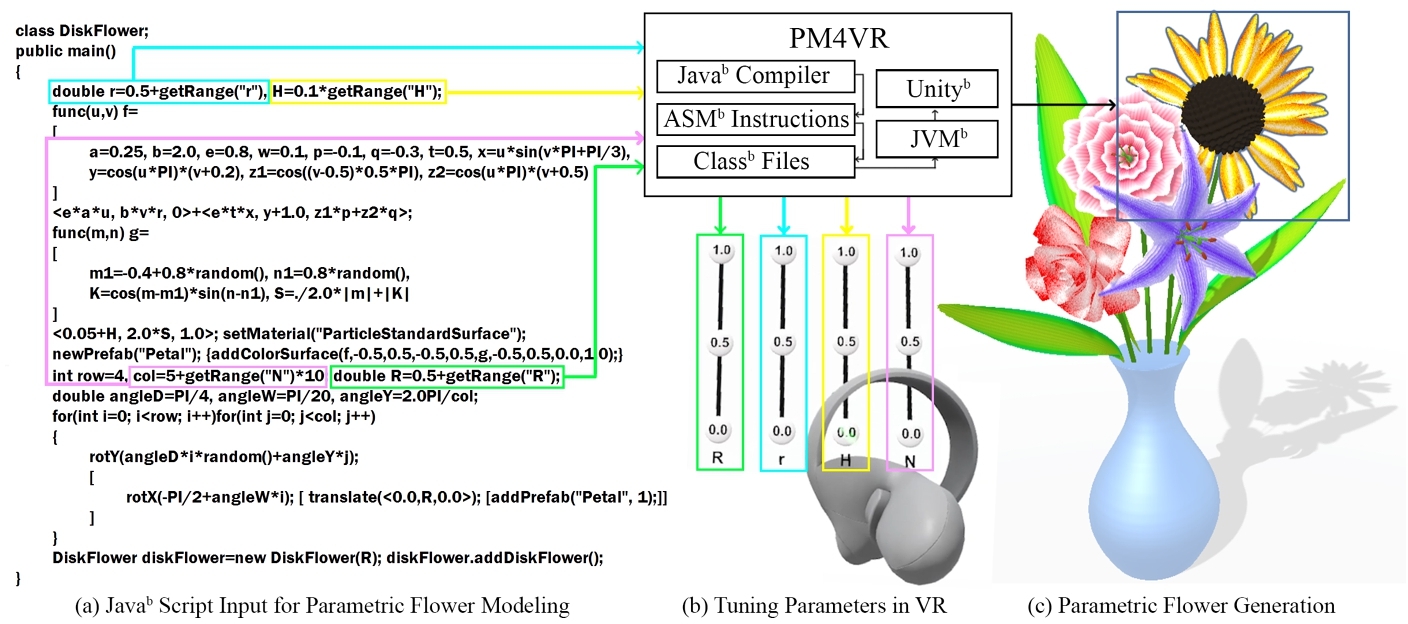
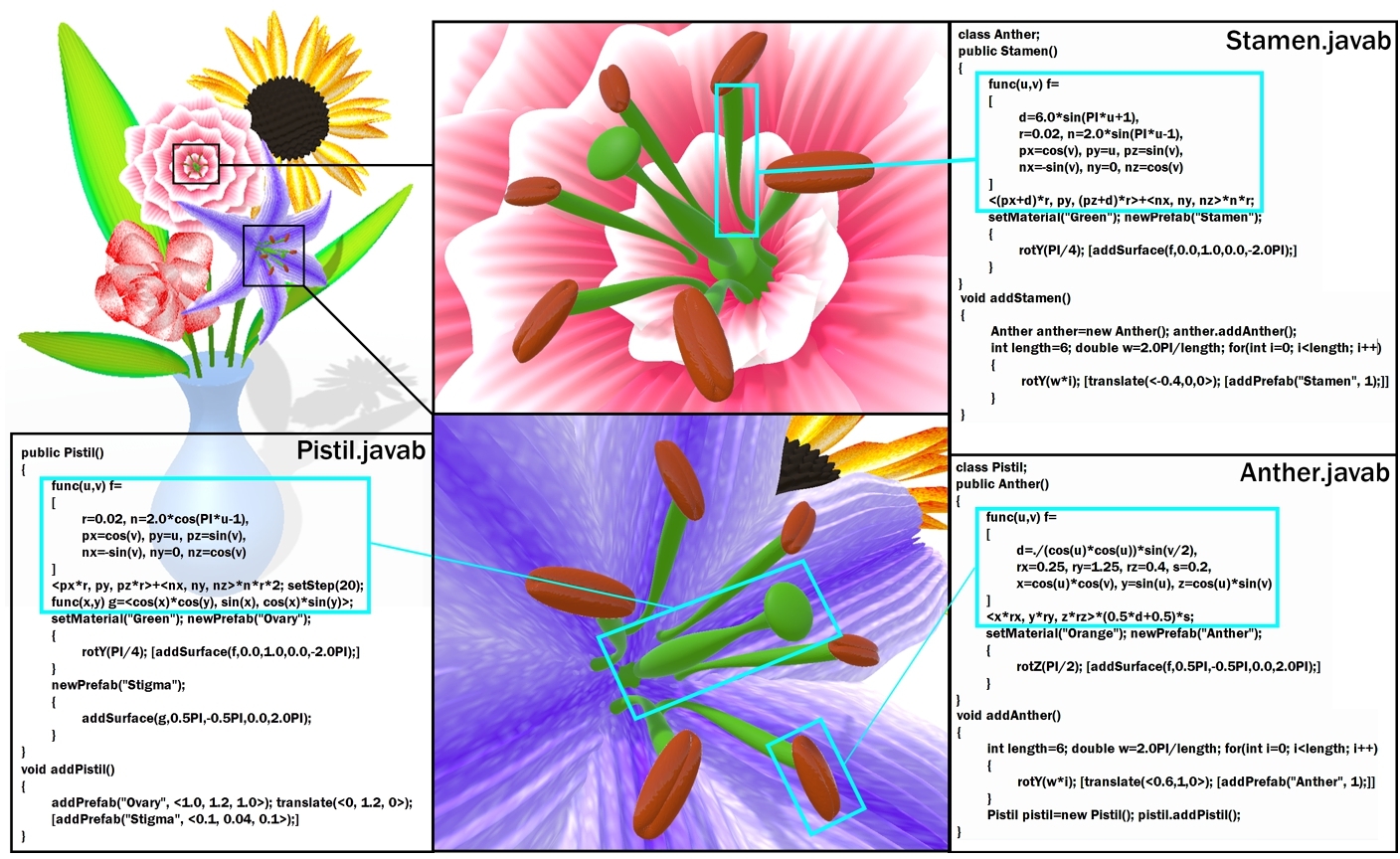
1 Introduction
Flowers possess intricate structures, including petals, stamens, pistils, anthers, stems, and other components that exhibit biological accuracy and aesthetic variation [19, 20]. Traditionally, artists have manually modeled these components, but this method is time-consuming and rigid, making it difficult to generate a variety of flowers or adjust designs rapidly. With the rapid development of computer graphics technologies, procedural modeling offers scalable and efficient methods to generate complex structures with minimal manual input [3, 18, 21]. Procedural modeling has transformed the landscape of digital content creation, proposing algorithms to generate complex geometries of virtual worlds that will otherwise require intensive manual labor [1, 23, 25]. One of the demanding areas of procedural content generation [22, 24] is the creation of natural elements, such as terrain [6, 7], landscape [5, 6], plants [2], trees [17], and flowers [26], which exhibit complexity.
In this paper, we introduce PM4Flower, a scriptable parametric modeling interface designed to streamline the procedural generation of flowers. Built on the foundation of PM4VR, PM4Flower enhances procedural modeling by offering a programming interface that allows users to create highly customizable flower models in virtual reality using simple scripting commands. PM4VR, which stands for Parametric Modeling for Virtual Reality, was initially developed for conceptual architectural design in VR environments [4] and has since been adapted for various industrial and artistic applications [8, 9, 10, 11, 12, 13, 14, 15, 16]. The primary objective of PM4Flower is to provide a VR-driven solution for procedural flower modeling by offering a scriptable interface that enables fast and customizable parametric flower creation. By dynamically modifying parameters, users can iteratively refine flower models in VR, fostering a deeper understanding of floral anatomy, making PM4Flower a practical tool for applications in digital content creation, video game authoring, scientific visualization, and even STEM education on VR platforms.
2 Technical Approach
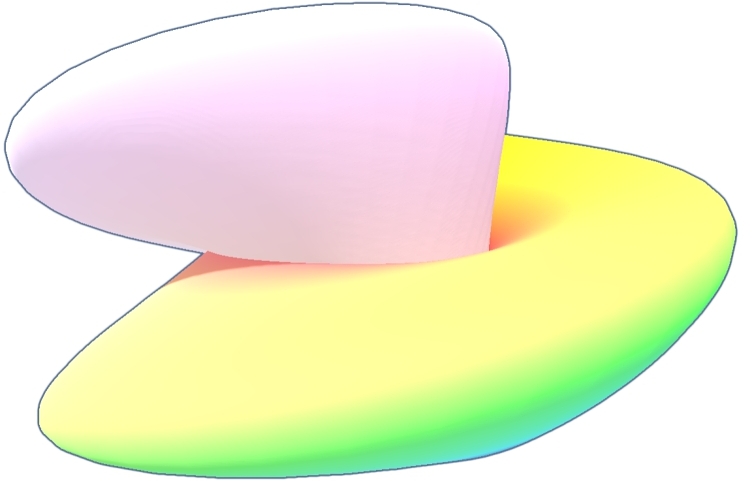
As shown in Fig. 1, PM4Flower enables designers to write Java♭ script as input for defining the parameters of flower models, as depicted in Fig. 1(a). Through this scripting interface, users can control various aspects of flower design, such as petal shape, color, and overall structure. By inputting these specifications in Java♭ script, designers have the flexibility to create complex flower models with ease. Once the script is executed within the PM4Flower interface and enter a VR setting, as illustrated in Fig. 1(b), user can further interact with and refine their designs. This VR-based interface allows for real-time adjustments of the parametric values, offering an intuitive, hands-on approach to fine-tuning the flower's geometry and aesthetics. Users can directly manipulate attributes like the shape and color of petals and the arrangement of floral elements, gaining immediate visual feedback as they adjust these parameters. Finally, as shown in Fig. 1(c), the detailed and finalized 3D parametric flower model is generated, providing a representation of the flower based on the initial Java♭ script and VR-based modifications.
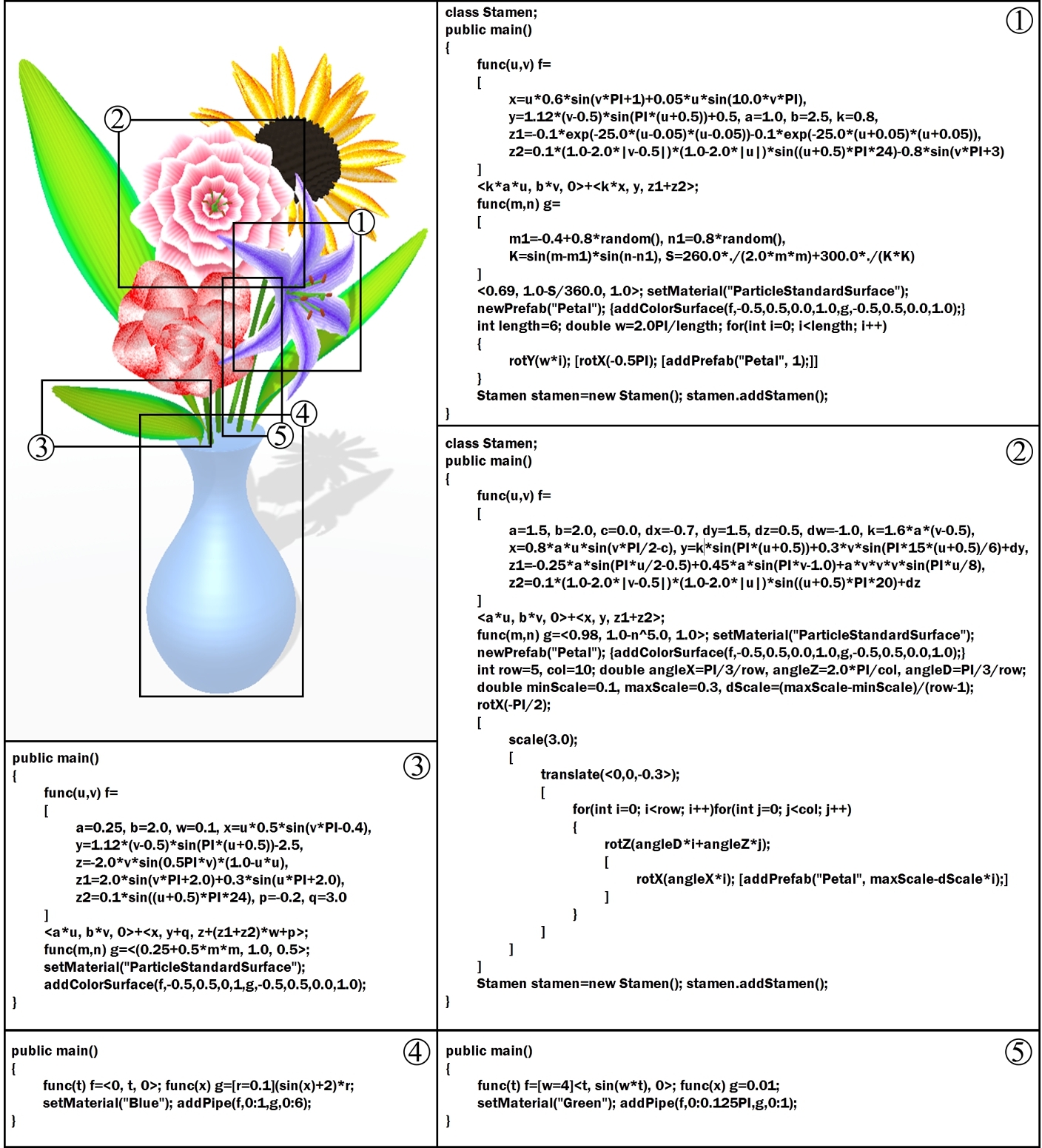
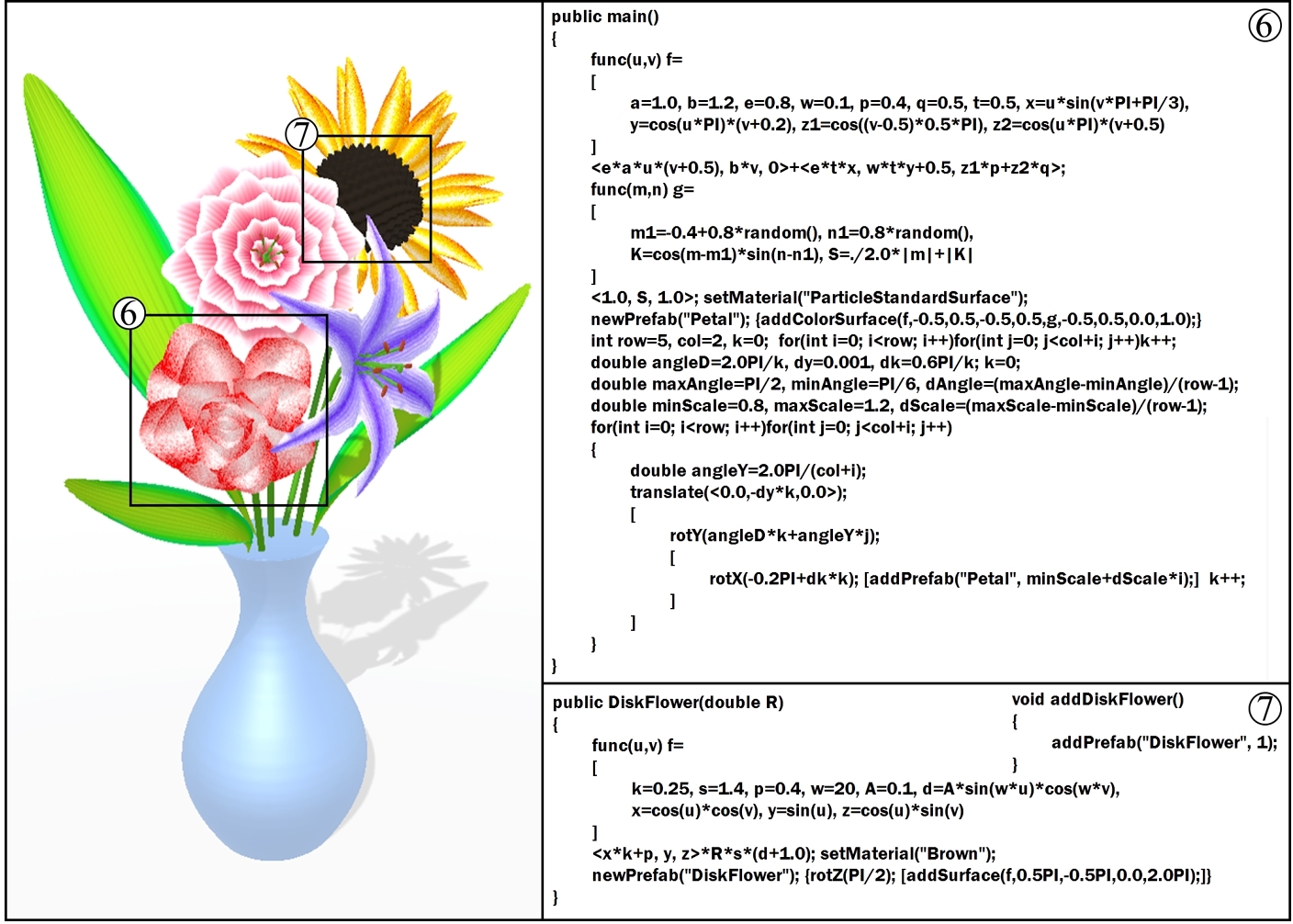
3 Experiment Results
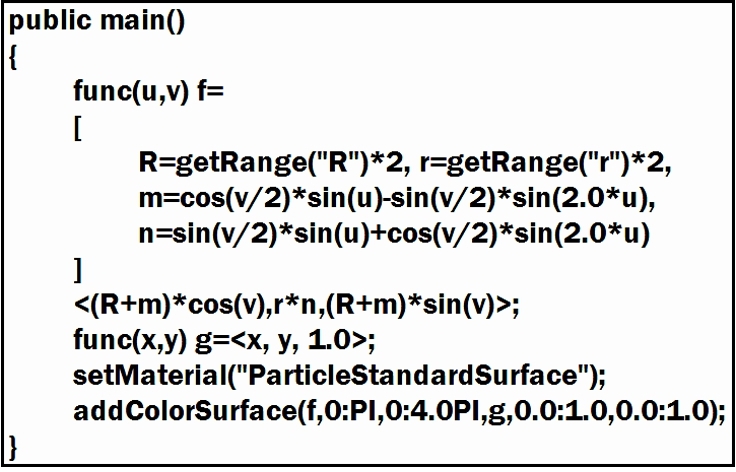
To demonstrate the effectiveness of the PM4Flower interface in generating a wide range of realistic flower models, we conducted several numerical experiments that showcase its creativity, flexibility, and adaptability in procedural flower generation. These experiments highlight the ability of PM4Flower to produce diverse and intricate floral structures through the use of Java♭ scripts. As shown in Fig. 2, various Java♭ scripts, such as stamen.javab, pistil.javab, and anther.javab, were employed to generate the corresponding components of a flower, illustrating the granular control PM4Flower provides over the individual parts of the flower model. Fig. 4 showcases different Java♭ scripts alongside their outputs, which include a variety of flower shapes generated using PM4Flower. For instance, the system successfully generates diverse floral forms: shape 1 represents a lily, shape 2 represents a peony, shape 3 corresponds to a leaf, shape 4 represents a vase, and shape 5 represents a stem. Similarly, Fig. 5 highlights additional Java♭ scripts and their outputs, including shape 6, a rose, and shape 7, which represents the disk flower of a sunflower. These examples illustrate the system's versatility in modeling different species of flowers, along with related structures such as vases and leaves. Finally, Fig. 7 demonstrates how users can further manipulate flower models in real-time using VR controllers. In this case, a user adjusts the parameters of a procedurally generated sunflower whose Jave♭ script is shown in Fig. 1, fine-tuning its appearance and structure interactively. This hands-on adjustment using VR controls emphasizes the creative and dynamic nature of the PM4Flower interface, allowing for highly customized and realistic flower generation. For a detailed demonstration, please refer to the user study video available via the following link: https://youtu.be/dPGkxOz2Avg
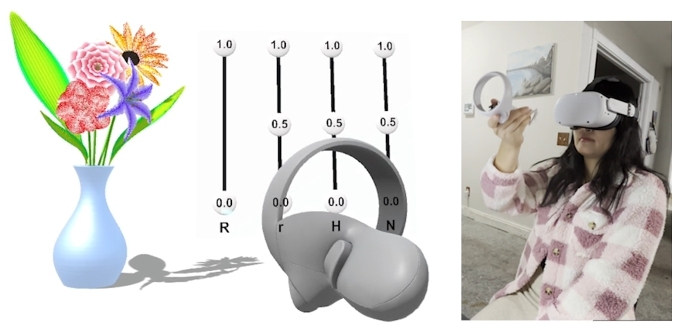
4 Conclusion
This paper introduces PM4Flower, a groundbreaking scriptable parametric modeling interface designed for procedural flower generation within the VR environment. The results from various experiments and user studies demonstrate that PM4Flower offers a robust and flexible solution for creating flowers procedurally. PM4Flower strikes a balance between user-friendliness and extensive customization options. The numerical experiments conducted reveal that PM4Flower not only reduces the manual effort required for modeling but also enhances design flexibility and creativity, positioning it as a valuable tool across various applications in VR/AR, gaming, STEM education, and visualization in virtual classrooms.
Future work will focus on expanding PM4Flower's capabilities to incorporate more complex plant structures, thereby broadening the scope of procedural generation beyond flowers. Additionally, efforts will be made to enhance its real-time performance in VR environments, ensuring that users can interact with and manipulate their designs in a fluid and responsive manner. This ongoing development aims to elevate PM4Flower's functionality and usability, making it an essential tool for users seeking to create realistic and dynamic plant models in virtual spaces.
References
- Bedrich Beneš, Ondrej Št'ava, Radomir Měch, and Gavin Miller. 2011. Guided procedural modeling. In Computer graphics forum, Vol. 30. Wiley Online Library, 325–334.
- Jianwei Guo, Shibiao Xu, Dong-Ming Yan, Zhanglin Cheng, Marc Jaeger, and Xiaopeng Zhang. 2018. Realistic procedural plant modeling from multiple view images. IEEE transactions on visualization and computer graphics 26, 2 (2018), 1372–1384.
- Mark Hendrikx, Sebastiaan Meijer, Joeri Van Der Velden, and Alexandru Iosup. 2013. Procedural content generation for games: A survey. ACM Transactions on Multimedia Computing, Communications, and Applications (TOMM) (2013), 1–22.
- Wanwan Li. 2022. PM4VR: A Scriptable Parametric Modeling Interface for Conceptual Architecture Design in VR. In Proceedings of the 18th ACM SIGGRAPH International Conference on Virtual-Reality Continuum and its Applications in Industry. 1–8.
- Wanwan Li. 2023. Intelligent Interface for Synthesizing Procedural Stone Forest Landscape. In 2023 2nd International Conference on Artificial Intelligence, Human-Computer Interaction and Robotics (AIHCIR). IEEE, 565–568.
- Wanwan Li. 2023. Synthesizing procedural landscape for volcanic eruption simulation in virtual reality. In 2023 7th International Symposium on Multidisciplinary Studies and Innovative Technologies (ISMSIT). IEEE, 1–5.
- Wanwan Li. 2023. Terrain synthesis for treadmill exergaming in virtual reality. In 2023 IEEE Conference on Virtual Reality and 3D User Interfaces Abstracts and Workshops (VRW). IEEE, 263–269.
- Wanwan Li. 2024. PM4Bag: A Scriptable Parametric Modeling Interface for Conceptual Bag Design Using PM4VR. In 2024 8th International Conference on Imaging, Signal Processing and Communications (ICISPC). IEEE, 178–181.
- Wanwan Li. 2024. PM4Car: A Scriptable Parametric Modeling Interface for Concept Car Design Using PM4VR.. In 2024 International Conference on Computer Graphics and Image Processing (CGIP). 1–6.
- Wanwan Li. 2024. PM4Fashion: A Scriptable Parametric Modeling Interface for Conceptual Fashion Design Using PM4VR. In 2024 International Conference on Advances in Computer Vision, Image and Virtualization (CVIV). 1–5.
- Wanwan Li. 2024. PM4Music: A Scriptable Parametric Modeling Interface for Music Visualizer Design Using PM4VR. In 2024 International Conference on Digital Signal Processing (ICDSP). 1–5.
- Wanwan Li. 2024. PM4Pottery: A Scriptable Parametric Modeling Interface for Conceptual Pottery Design Using PM4VR. In 2024 International Conference on Automation, Robotics, and Applications (ICARA). 1–5.
- Wanwan Li. 2024. PM4Tree: A Scriptable Parametric Modeling Interface for Decorative Tree Design Using PM4VR. In 2024 11th International Conference on Soft Computing & Machine Intelligence (ISCMI). IEEE, 1–5.
- Wanwan Li. 2024. PM4Urban: A Scriptable Parametric Modeling Interface for Conceptual Urban Layout Design Using PM4VR. In 2024 13th International Conference on Computer Technologies and Development (TechDev). IEEE, 1–5.
- Wanwan Li. 2024. PM4WallArt: A Scriptable Parametric Modeling Interface for Conceptual Wall Art Design Using PM4VR. In 2024 International Conference on Computer and Communication Systems (ICCCS). 1–4.
- Wanwan Li. 2024. PM4WireArt: A Scriptable Parametric Modeling Interface for Conceptual Wire Art Design Using PM4VR. In 2024 International Conference on International Conference on Information and Computer Technologies (ICICT). 1–6.
- Steven Longay, Adam Runions, Frédéric Boudon, and Przemyslaw Prusinkiewicz. 2012. TreeSketch: Interactive Procedural Modeling of Trees on a Tablet.. In SBIM@ Expressive. Citeseer, 107–120.
- Pascal Müller, Peter Wonka, Simon Haegler, Andreas Ulmer, and Luc Van Gool. 2006. Procedural modeling of buildings. In ACM SIGGRAPH 2006 Papers. 614–623.
- Sophie Nadot and Laetitia Carrive. 2021. The colourful life of flowers. Botany Letters 168, 1 (2021), 120–130.
- Louis Ronse de Craene, Akitoshi Iwamoto, Kester Bull-Hereñu, Patricia Dos Santos, Javier A Luna, and Jennifer Farrar. 2014. Understanding the structure of flowers—The wonderful tool of floral formulae: A response to Prenner & al.Taxon 63, 5 (2014), 1103–1111.
- Michael Schwarz and Pascal Müller. 2015. Advanced procedural modeling of architecture. ACM Transactions on Graphics (TOG) 34, 4 (2015), 1–12.
- Noor Shaker, Julian Togelius, and Mark J Nelson. 2016. Procedural content generation in games. (2016).
- Ruben Michaël Smelik, Tim Tutenel, Klaas Jan de Kraker, and Rafael Bidarra. 2011. A declarative approach to procedural modeling of virtual worlds. Computers & Graphics 35, 2 (2011), 352–363.
- Julian Togelius, Georgios N Yannakakis, Kenneth O Stanley, and Cameron Browne. 2011. Search-based procedural content generation: A taxonomy and survey. IEEE Transactions on Computational Intelligence and AI in Games 3, 3 (2011), 172–186.
- Torsten Ullrich, Christoph Schinko, and Dieter W Fellner. 2010. Procedural modeling in theory and practice. (2010).
- Siyuan Wang, Junjun Pan, Junxuan Bai, and Jinglei Wang. 2020. Flower Factory: A Component-based Approach for Rapid Flower Modeling. In 2020 IEEE International Symposium on Mixed and Augmented Reality (ISMAR). IEEE, 12–23.

This work is licensed under a Creative Commons Attribution 4.0 International License.
ICSIE 2024, December 02–04, 2024, Derby, United Kingdom
© 2024 Copyright held by the owner/author(s).
ACM ISBN 979-8-4007-1776-5/24/12.
DOI: https://doi.org/10.1145/3708635.3708645